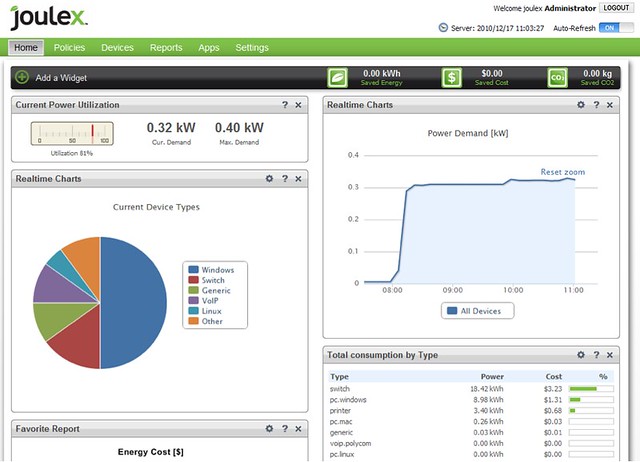
After I mentioned in this post that JouleX had recently updated their Energy Manager product to version 2.5 and all the extra functionality that brought, I was curious to find out a little more about them.
I talked to Tim McCormick, JouleX’ VP Marketing and Sales and Mark Davidson, their Sustainability Officer.
I was intrigued to discover that the company was founded in 2009 by former execs from Internet Security Systems, a security company which had been bought by IBM.
Having moved on from ISS, instead of building another app to scan networks looking for threats and vulnerabilities, they created software to go out over the network and sniff out the power consumption information of all devices on the network! They call their solution JouleX Energy Manager (JEM).
What exactly does JEM do? Well, this is where it gets interesting.
JEM pulls in energy information from all kinds of devices. In the office environment, it grabs energy data from computers, printers, VoIP phones, hubs, switches, access points, you name it – anything with an IP address. Similarly in a data centre environment. However, where it really starts to stand out on its own is when it hooks into facilities’ machinery. JEM can grab energy utilisation figures from access control systems, PDU’s, video cameras, CRAC’s, lighting, even HVAC systems.
Even more interestingly, JEM can harvest all this energy utilisation data without needing to install any software agents, or to deploy any smart IP devices/PDU’s or wireless sensors. Nor does it require any changes to be made to the network, or the security of the network. Quite an achievement.
So what does JEM do with all this information?
Well, as you’d imagine, JEM has quite a comprehensive analytics engine which slices and dices that info by energy cost, energy usage, CO2e, device, manufacturer, date, time, location, business unit, any way you want to look at it. Also what-if analyses allow you to check out the savings from policies before rolling them out, and JEM can even calculate the energy ROI for new buy equipment versus legacy allowing you to validate purchase decisions before buying.
Finally, JEM also has an events-based policy engine which looks at data feeds and implements policies based on events or thresholds. With their JouleX Mobile phone app – the event could be turn off all the devices in Tom’s office (printer, scanner, VoIP phone, computer, lights, wireless access point, etc.) when Tom is more than 500m from the building (using the phone’s inbuilt GPS), and turn them all back on when Tom returns.
In data centres, under utilised servers can have the power reduced to their CPU’s, cutting their energy consumption (JouleX call this Load Adaptive Computing) and organisations can even take advantage of JouleX’ ability to interface with ADR and OpenADR to reduce energy use and sell the unused electricity back to their utility.
In the next version of JEM JouleX will roll out Load Adaptive Networking – this will scale back the power utilisation of routers, switches and other networking equipment when they are not in use – an area which, to-date, has been very poorly addressed.
JouleX have a very comprehensive application here. They have stellar customers and partners. I have a feeling this is a company we’ll be hearing a lot more about.
Photo credit Tom Raftery

